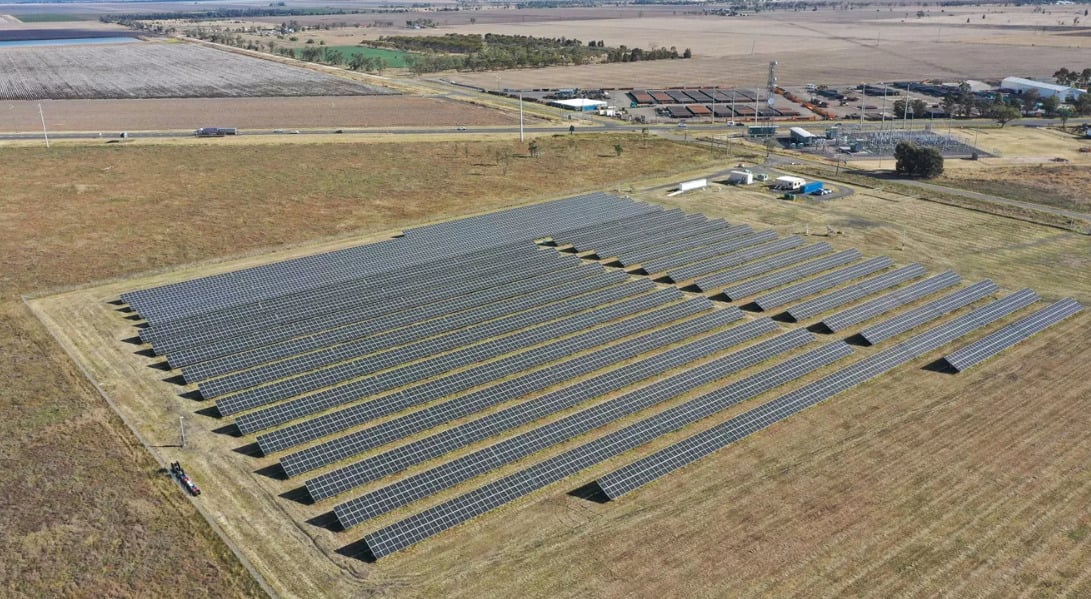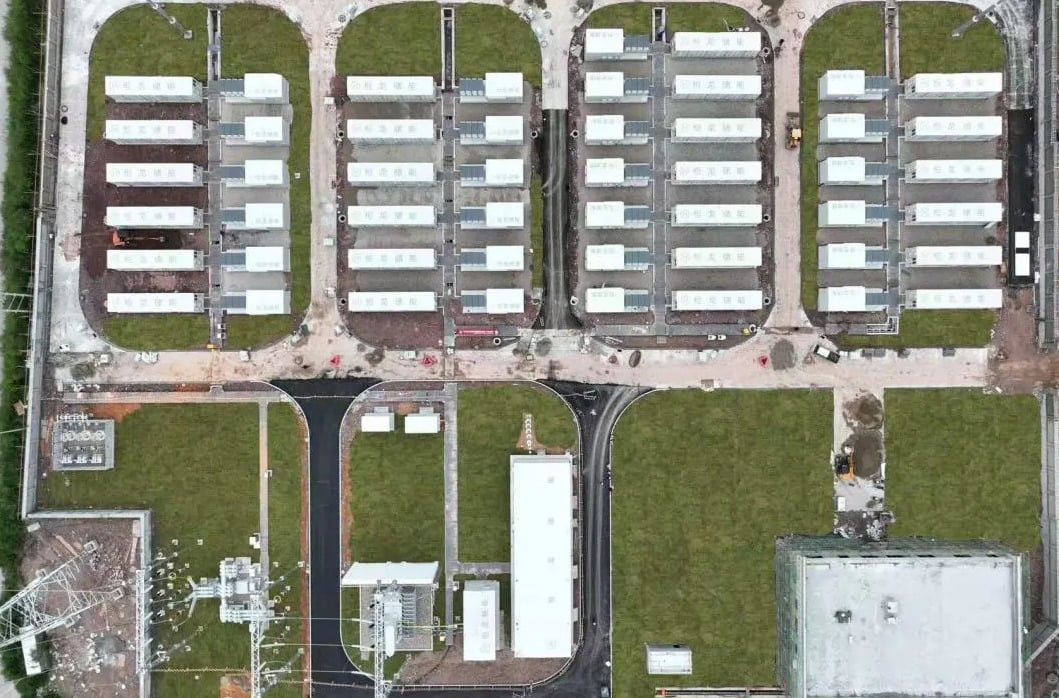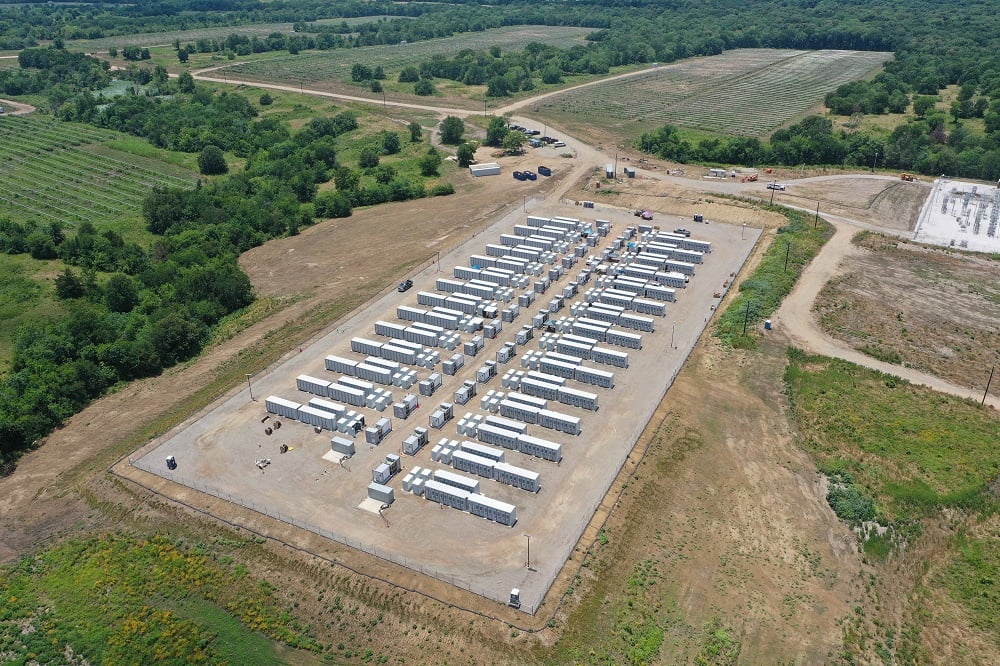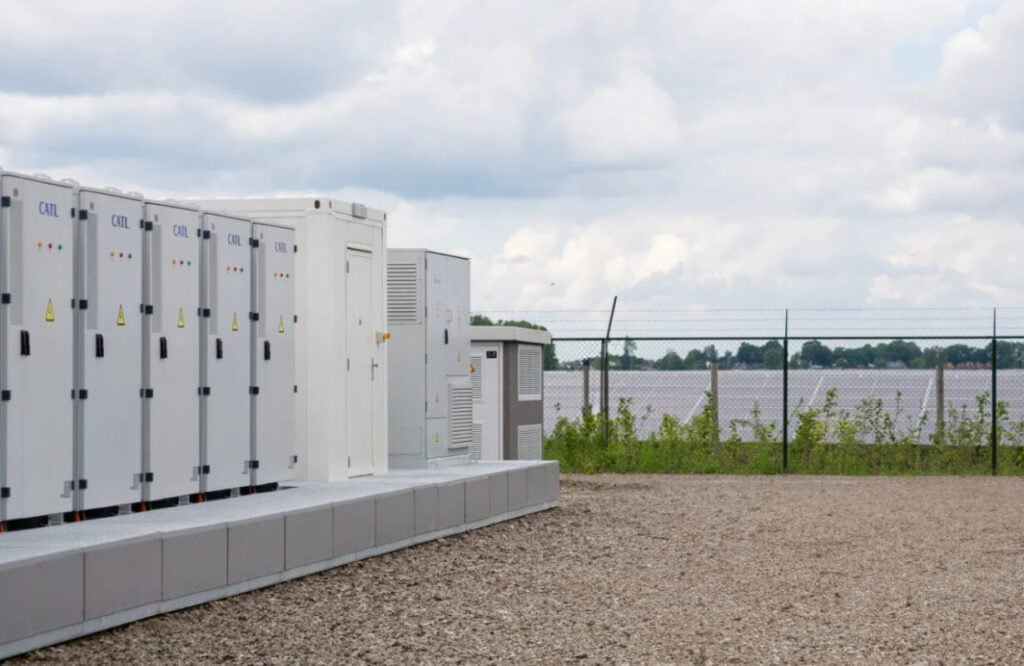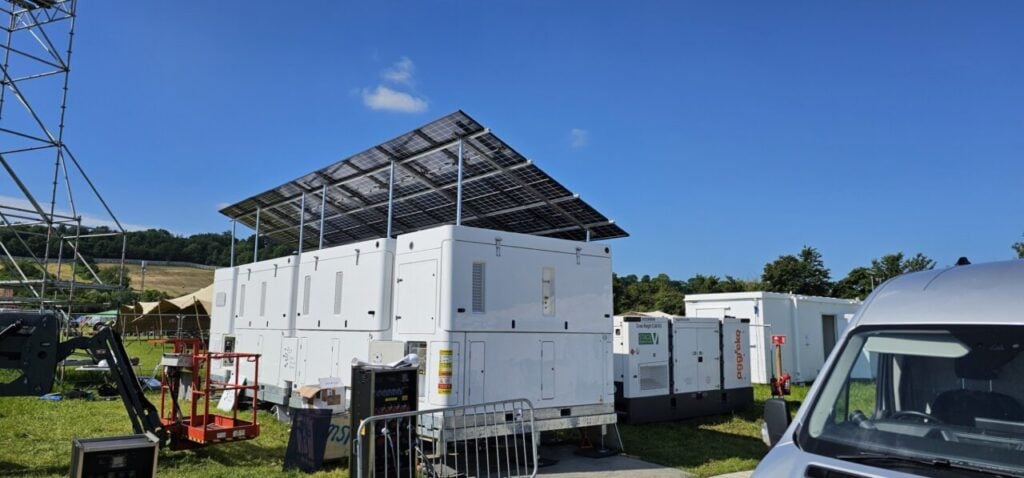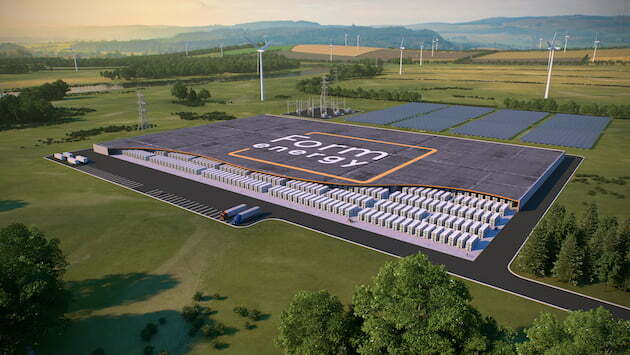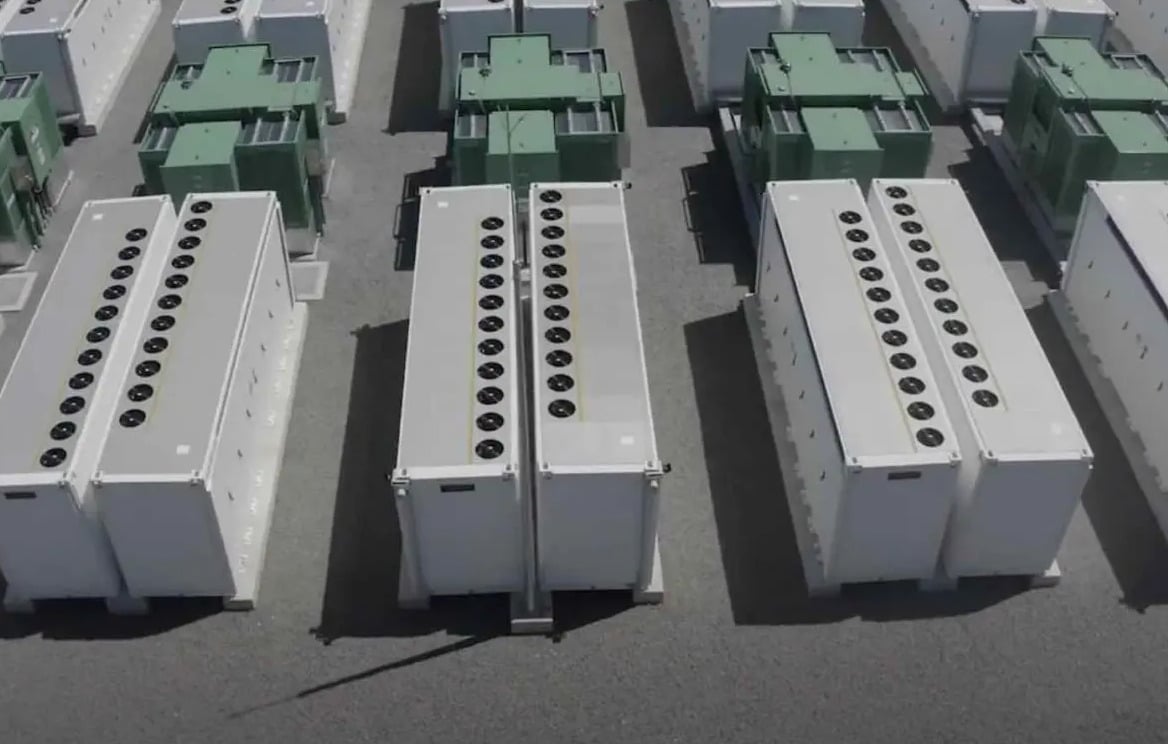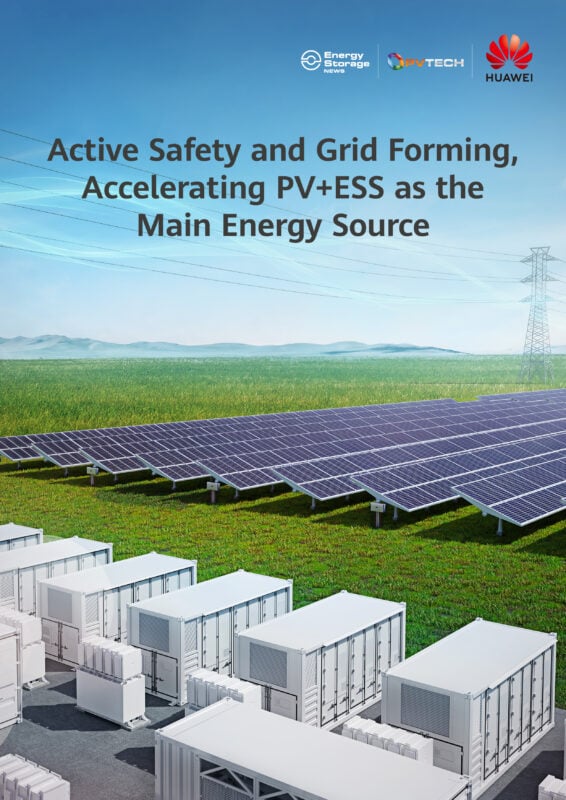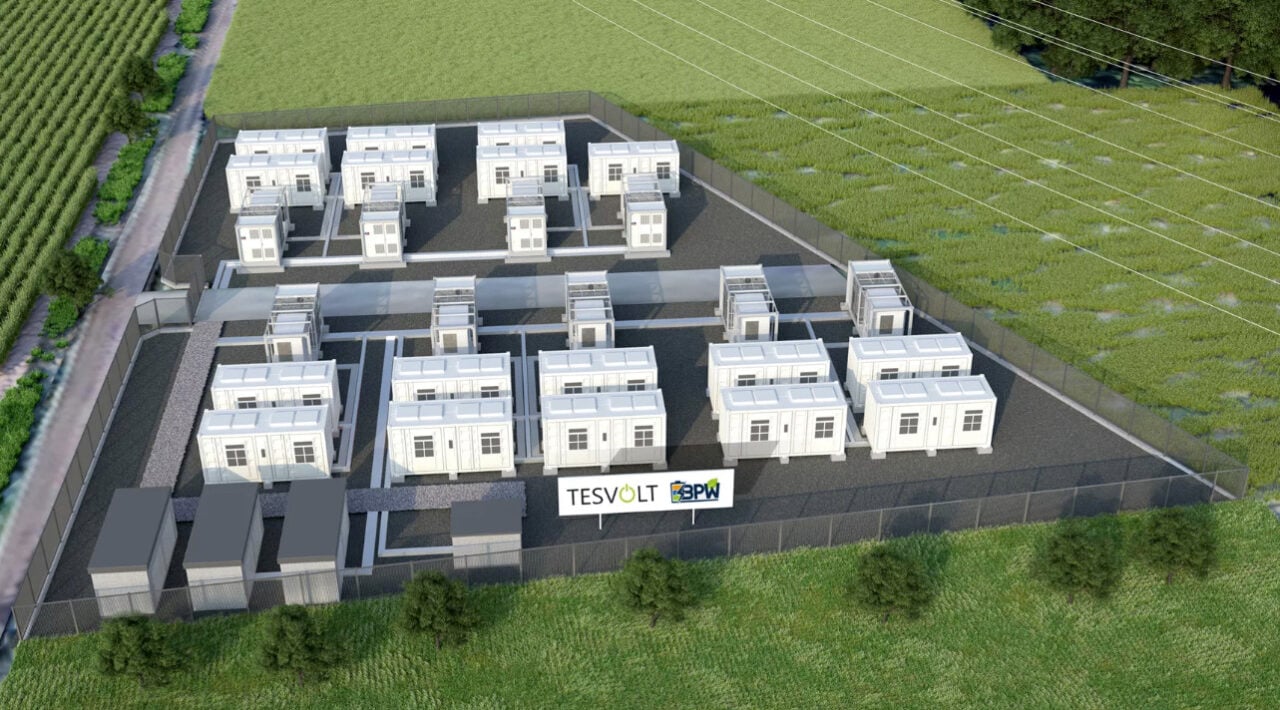Combining the two energy assets helps the site stabilise the national grid. Excess energy generated by the solar PV plant is captured and stored in the BESS for when demand spikes.
The project’s engineering, procurement and construction (EPC) work was carried out by Spanish company Gransolar.
Christopher Curtain, senior managing director for Asia-Pacific at OMERS Infrastructure, the Canadian infrastructure fund that owns a stake in FRV, said Dalby’s connection into the grid is “another great milestone for FRV Australia,” and the organisation will “leverage the learnings to continue to grow FRV’s Australian portfolio”.
See the full original version of this article on PV Tech.
‘World’s first’ large-scale semi-solid BESS connects to grid in China
The system uses 280Ah semi-solid batteries produced by Weilan New Energy, according to local reports, and has been claimed as the largest project of its type using the technology.
Semi-solid and solid-state batteries use solid electrolytes rather than the liquid ones that conventional lithium-ion batteries use. The technologies hold promise for electric vehicle (EV) and energy storage system (ESS) applications with potential for superior energy density, charging time, safety and longevity, but the tech has yet to be deployed commercially at scale.
Power solutions firm Kehua Tech meanwhile supplied the power conversion systems (PCS), Kehua said last week (3 July). Kehua installed 25 sets of 5MW skids using 1.25MW high-performance energy storage converters, which are connected in parallel to a single 5,000kVA transformer, achieving a 35kV AC grid-connected output.
Numerous large-scale energy storage projects using novel technology are being deployed in China. Last week, it was reported that the first half of the world’s largest sodium-ion BESS came online, in Hubei province.
March saw the world’s first large-scale project using Energy Vault’s gravity energy storage tech connected to the grid, while two years ago, a 400MWh vanadium redox flow battery (VRFB) was commissioned, in Dalian.
24M is one company notable for advancing the commercialisation of semi-solid battery technology.
LG ES Vertech CEO talks system integrator strategy, explains BESS manufacturing ‘pause’
NEC ES had been an early leader in the battery energy storage system (BESS) integration space and might have been the first to get to a gigawatt of deployments had owner NEC not decided to pull the plug due to a reported lack of profitability in mid-2020.
NEC ES had integrated its BESS hardware with third-party battery cells with a proprietary controls software platform, AEROS. Its acquisition potentially combined one of the sector’s biggest names in system integration with one of the world’s largest battery OEMs.
As regular readers will know, LG Energy Solution (LG ES) then launched its system integration arm at last year’s RE+ show in Las Vegas, highlighting the importance of the North American market in its strategy.
Company representatives have said that the competitive advantages of the new business, LG ES Vertech, include the ability to leverage the parent company’s know-how, experience and volumes of lithium iron phosphate (LFP) manufacturing as well as downstream capabilities provided by AEROs and other NEC ES assets.
Before we dive into our interview with Jaehong Park, which took place a couple of weeks ago, we should address the news that LG ES is hitting the pause button on its new dedicated 17GWh LFP cell production line for BESS products in the US.
It was widely reported in local media this week from Arizona, where the line will be sited alongside production facilities for electric vehicle (EV) batteries that LG ES has temporarily put on hold work for the BESS-dedicated second phase of the factory’s construction in the town of Queen Creek.
In a note sent to Energy-Storage.news this week (3 July), Jaehong Park of LG ES Vertech said that the pause is in fact to accommodate planned higher volumes of manufacturing, rather than due to a dip in expected demand.
“LG Energy Solution is adjusting the pace of planned investment execution efficiently and flexibly according to market conditions, and focusing on optimising our operations,” Park said.
“As part of such efforts, LG Energy Solution is adjusting our ESS-purpose US manufacturing plan to get products to market faster. This includes a slow-down of the construction of our Arizona ESS battery facility as part of our broader approach that will allow us to reach higher US production volumes more quickly than previously forecasted. Meanwhile, the construction of cylindrical EV battery facility is ongoing as planned.”
“We remain firmly committed to US manufacturing, and can confirm that we will meet all of our domestic content requirements by Q4, 2025.”
Park added that the company cannot yet reveal specific details of the “new approach,” but called it an “exciting opportunity”.
Last week, we published Jaehong Park’s views—excerpted from same interview as the following conversation—on the advantages of vertically integrating everything from battery hardware and software to power conversion system (PCS) and other key technologies.
These included the idea that customers have one service provider or vendor to contract with for their projects, bringing accountabilities for all levels of the project to one system integrator, and the higher degree of control it offered LG ES over its products and solutions would be deployed in the field and operated.
‘Strategic movement to acquire NEC ES’
Jaehong Park’s professional journey in the energy storage business began in 2010, and says that even then, he and colleagues were anticipating the rapid growth of storage to take off in the US in five years’ time.
It seemed the wait would continually be extended by another five years as time went on, but today, he says, after years of pilot projects and work to ensure the technology would benefit stakeholders, “energy storage is an important part of the energy sector now”.
“After I joined LG as a part of the ESS team, we were mainly focusing on battery manufacturing technology and processing technology to make it make economic sense.”
Park says he thinks LG ES contributed significantly to helping the industry achieve economies of scale and to make the technology feasible to address the needs of the energy transition, which few would be likely to argue with.
“After a while we found that energy is something more than just a manufacturing technology, and that’s the reason why as a strategic movement, we decided to acquire NEC ES. The main reason why we decided to take that path was because energy is not just a commodity,” Park says.
LG ES decided that along with the hardware that stores the energy, control technologies, data science and analytics are the “key technologies that play such an important role to improve the efficiency of energy storage.”
“Being a battery supplier [only] would not help us to collect that data and they will not help us to address those pain points that the customer has.”
After the acquisition, LG ES carried out “extensive and intensive research” on directions to take in order to satisfy future demand, and as of December last year had already booked or was in negotiations for 10GWh of system integration orders from North American customers.
Park says that with the US manufacturing line on the way, conversations are being held with customers daily on how best to utilise that new capacity.
It’s a far cry from his early days in the industry, but when asked what the sector looks like now compared to how it did in 2010, he says some things have stayed the same and others have changed dramatically.
For example, 14 years ago the cost of lithium-ion battery storage was US$1,000/kWh. But that had changed just two years later when LG ES bid for one of the world’s biggest projects at the time for utility Southern California Edison (SCE).
The target price for the 32MWh Tehachapi project was “somewhere slightly lower than US$600/kWh,” which was a “crazy” price, but LG ES achieved it and deployed the project.
Today, LG ES can compete for prices that average at lower than US$200/kWh.
Another big change has been in energy density, with earlier commercially available standardised BESS solutions delivered in 40-foot containers. Today, 20-foot ISO container-type configurations are the norm, packing 5MWh of storage capacity or even more.
Other things that have changed include the development of safety standards and protocols, while the increasing standardisation of software is also a change from the highly customised projects of the past.
“The software itself to integrate so many different components like PCS and HVAC and cooling systems and batteries are no longer a differentiator,” Park says.
“Now, it’s more than that, [its] trading platforms and then machine learning technology and AI, all those things to improve revenues from the customer perspective, and decrease the operational expenditure during the lifespan.”
Data centres add major demand to already-booming US market
The US market has changed enormously since 2010 of course, and from inflection points we might judge as being from about 2015 onwards, almost every successive year sees records broken for utility-scale deployments. At the beginning of this year, LG ES forecast 30% growth in the US market during 2024.
Market opportunities today are more spread around the country from being extremely concentrated in California first and more recently Texas, although it is still a patchwork of markets based around utilities and transmission and market operators in scattered states.
There are some interesting trends emerging, says Jaehong Park, including the rapid growth in demand for electricity for data centres as AI use proliferates.
“California was the state where policy drove the ESS market at the beginning [with the AB2514 procurement mandate for utilities] in 2017-2018, and that was the only sizeable market. Beforehand, there was a market in PJM for frequency regulation, but everyone knew that it would be saturated sometime later due to the limitation of the necessity of the frequency regulation tool,” Park says.
Then, Texas’ ERCOT grid was a major driver of market growth for the US due to the volatility of wholesale electricity prices, which BESS is well-placed to capture.
An LG ES Vertech project site in Texas’ ERCOT market. Image: LG ES
Now, Park says, LG ES has gigawatt-hour-scale projects in Arizona and Nevada contracted or in negotiation, and others scattered around the country in territories including the Midcontinent Independent System Operator (MISO) market.
However, plans all over the US to invest tens of billions of dollars into data centres will create a “big problem,” in terms of providing stable sources of low-carbon energy to meet their demand, which for renewable energy and energy storage could be a big opportunity to solve.
“If you look at the infrastructure, the question is: is the infrastructure really ready and can Renewable Energy Credits (RECs) solve the problem? No, they cannot.”
RECs are structured so that a data centre developer or owner in Georgia could buy RECs from Texas and offset consumption, making it, on paper, 100% renewable-powered.
“In reality, you need power and energy within Georgia, where you have interconnection to your data centre.”
Park says he has found that “so many projects are under-developed” in that regard, and that data centre-driven energy requirements will be a big opportunity for energy storage. LG ES Vertech is seeking to focus on this trend and “try and follow where the market goes,” he says.
LG ES Vertech developing revenue optimisation software
Software will be key to capturing those and other opportunities and, as Jaehong Park has said in the past, leveraging NEC ES’ AEROS platform and its capabilities of modelling and optimising revenues against market conditions a key part of LG ES Vertech’s strategy in that respect.
The market will be a diverse one, including solar-plus-storage projects that help deliver renewable energy to the grid or corporate customers more smoothly along long-term power purchase agreement (PPA) contracting structures, to standalone battery storage assets that operate largely in merchant markets.
Volatility of wholesale electricity prices in merchant markets like ERCOT will continue to grow, Park says, and LG ES Vertech is developing software to maximise capture of that volatility through energy trading, or arbitrage.
Guaranteeing system availability, is more critical to the business case for merchant projects than it is for projects tied to PPAs, for example.
“Guaranteeing availability is one of the important things [even with a PPA-type contract], but in the merchant market, if you lose 5% of the market opportunity or even less, you could lose maybe 30% of the revenue, because the wholesale market price is quite spiky,” Park says.
“If you lose [availability in] a specific time period when the price is really high, then you lose most of the revenue stream.”
Localisation of value chain a ‘key differentiator’ in US market
Although LG ES had taken its decision to expand its battery manufacturing footprint in the US before the passing of the Inflation Reduction Act (IRA), that and other legislation like the Bipartisan Infrastructure Law are now the main drivers for growth of BESS and clean energy tech manufacturing, according to Jaehong Park.
“We already decided that localisation is one of the key differentiators for us to be the major player in the United States, before the IRA actually kicked in,” Park says, adding that LG ES was fortunate that it was already a recipient of policy support before the landmark legislation passed.
LG ES representatives with local officials and other guests at a stakeholder meeting near the site of the new factory in Queen Creek, Arizona, US in April this year. Image: LG Energy Solution
The IRA and Bipartisan Infrastructure Law’s direct support for domestic manufacturing and tax credit incentives for making and deploying domestically aligned with LG ES’ existing plans and activities the CEO claims.
“Localisation is not just simply building a factory; you have to have the entire value chain and supply chain built up in the United States. Otherwise, if you build a factory, but if you import every core material from outside the United States, it doesn’t really work.”
LG ES already had partnerships with US automotive industry OEMs in place and already has operational production facilities in the country, even without policy support via the Biden Administration’s legislation, localisation there made sense for the company.
“Now, the situation is really favourable for us to be a local player,” Park says.
While the 17GWh Queen Creek production plant in Arizona will represent a significant portion of the overall US manufacturing base when it opens, LG ES Vertech is seeing “extremely high demand,” and expects the market to continue growing.
As alluded to above, the company is considering options to ramp up further and meet that demand.
However, there do remain a few issues that could impact demand, and the ability of manufacturers like LG ES to assess with certainty the outlook for their business in the coming years, and chief among those are permitting and interconnection delays, with US grid operators having something like 100GWh of energy storage projects in their queues to connect to the grid.
Eneos Renewable Energy to retrofit BESS at solar PV plant with Japanese government support
Under the scheme, subsidies can be applied for by operators and owners of solar power plants that receive the feed-in premium (FiP). The FiP is the state’s market-based financial compensation mechanism for large-scale PV and the successor to the feed-in tariff (FiT).
Eneos Renewable Energy appears to be the first to publicly announce its success in the scheme, called “Support Project for the Introduction of Storage Batteries Combined with Renewable Energy Sources,” for the FY2023 budget period.
Its battery energy storage system (BESS) asset at the JRE Fukuchi 3 Solar Power Plant must be in operation by a date in February 2025 and delivered at a cost of less than JPY120,000/kWh (US$746.34/kWh).
The company did not reveal the expected output or storage capacity of the BESS to be retrofitted at the 2.3MW PV plant in Fukuoka Prefecture, on the southern Japanese island of Kyushu.
It did note however that the subsidies would cover part of the investment cost, and that the BESS asset will be operated in line with a plan jointly developed between Eneos Renewable Energy (ERE) and Mitsubishi Research Institute (MRI).
The pair’s planning system will utilise MRI’s distributed energy resource (DER) control platform, MERSOL.
The system was developed in recognition that planning optimal market transactions, or optimisation, of BESS assets has been challenging in Japan as the platforms for forecasting renewable energy production and electricity demand have not been effectively linked with bidding and transaction platforms.
ERE said in June that it intends to utilise the planning system for its own energy storage projects, as well as offer it to third parties for whom it will operate assets. Such a system can help provide stable supply of variable renewable energy (VRE), and minimise imbalances between supply and demand.
Battery storage to help enable FiP solar projects to maximise profits
The government scheme was also held for FY2022. Chinese tech company Huawei, which was part of a special purpose vehicle (SPV) company selected in that previous round, noted that the feed-in premium requires solar PV plants to sell electricity to the grid when prices are high, and that batteries can better enable them to do this.
Huawei also said that while projects that previously received the FiT can be converted to FiP remuneration schemes, the business case without battery storage could be challenging. Satsuma Green Power 2 solar PV plant was one of the first such plants in Japan to make this conversion.
Satsuma Green Power 2 solar PV plant, also in Kyushu, was developed in the SPV with Japanese company Daiwa Energy Infrastructure’s subsidiary CO2OS, using Huawei’s LUNA 2000 BESS equipment. The market aggregator is Toshiba energy Systems and Solutions.
A Huawei representative told Japanese technology news outlet IT Media in May that the batteries enabled better “output controls” of the power plant, which went online in 2022, particularly as daytime solar generation in Kyushu often exceeds demand.
The support scheme is one of a number of programmes the Japanese government has introduced to promote the use of energy storage. Those taking part in the FiP-energy storage scheme cannot combine it with support from other subsidies, but they are allowed to add further generation or storage capacity to the project once fully operational.
Although market-based revenues can be earned in the country’s recently liberalised electricity sector, these are often uncertain and potentially insufficient to provide a solid base for investment of the kind seen in more mature energy storage markets including the US and the UK.
Read more ESN coverage about and related to Japan.
Energy-Storage.news’ publisher Solar Media will host the 2nd Energy Storage Summit Asia, 9-10 July 2024 in Singapore. The event will help give clarity on this nascent, yet quickly growing market, bringing together a community of credible independent generators, policymakers, banks, funds, off-takers and technology providers. For more information, go to the website.
SemperPower, Corre Energy and PowerField launch large-scale Netherlands BESS projects
It would require capex of around €300 million (US$325 million) of which €7 million is being invested in the early-stage development already, with Corre’s share already deployed. Final investment decision (FID) is being targeted for late 2025 with a commercial operation date (COD) expected in 2026.
SemperPower, which is owned by investor Return Energy, is the owner and operator of the Netherlands’ two largest operational BESS units. It will provide battery infrastructure sourcing, development and operational expertise and finalise offtake agreements and project financing, having done so for its two projects already. The JV is targeting a fixed 10-12 year offtake with no market revenue risk.
The combined CAES and BESS will create a multi-duration energy storage project which Corre may model at its other sites. It is developing large-scale projects internationally with the most advanced of these in Netherlands and Germany- we interviewed the company earlier this year (Premium access). The firm is primarily a project developer, focusing on CAES up until now.
PowerField commissions country’s largest PV co-located BESS
Independent power producer (IPP) PowerField has put a 52MWh BESS at a PV plant into operation, the largest co-location in the Netherlands, it claimed. Concurrent with that it has launched a new business unit, PowerField Energy, which will sell solar energy into the electricity grid.
The company is aiming to have 1GWp of solar and 2GWh of energy storage in the Netherlands by 2028, alongside EV charging points via subsidiary PowerGo.
The solar and storage project in Wannepervee combines 28MWp of solar with a 52MWh BESS. It is developing a 12MWh project near another of its solar PV plants, in Emmen.
Grid operator Enexis and PowerField have agreed a time-bound contract for the projects in Wanneperveen and Emmen, whereby PowerField will have flexible access to the electricity grid when transport capacity is available. At times when there is insufficient grid capacity available, the BESS stores the electricity generated by the PV plants.
It comes amidst the Dutch government announcing grants for co-located projects starting in January 2025, as reported recently by Energy-Storage.news.
The flurry of triple-digit-megawatt BESS project news in the Netherlands, following announcements by Lion Storage and Giga Storage last month, come after the government provided clarity on a ‘flexibilisation’ of grid fees. In an interview with Energy-Storage.news, research firm Aurora said this could boost the grid-scale energy storage market substantially (Premium access).
Battery storage at Glastonbury: technology helps power world’s largest festival
Much of that power comes from generators running on HVO biofuels but many are integrated with battery storage units as backup, according to Progen Power, while a megawatt-scale solution powered one of the festival’s most well-known spectacles.
MSP Technologies: 1MW/3MWh BESS for Arcadia stage
MSP (Multi Source Power) Technologies provided a pre-charged battery energy storage system (BESS) to utility Ecotricity to power the Arcadia stage, which featured DJ sets from Fatboy Slim, Hot Chip and Eric Prydz from inside the head of a giant metal dragonfly structure, pictured above.
“(Ecotricity CEO) Dale Vince was convinced he could help to decarbonise the festival environment so commissioned us to construct the BESS, specifically for festival or portable power needs. The stage and BESS are a phenomenal achievement,” MSP CEO Simon Patterson told Energy-Storage.news.
The 1MW/3MWh BESS covered the load during the three days of performances as well as the five pre-show days with the help of HVO biofuels and a solar array for charging. It comprised six blocks with lithium iron phosphate (LFP) battery cells from Hithium and power conversion systems (PCS) from EPC Power.
During the show loads jumped from below 250kW to over 720kW, sometimes in the course of 20 milliseconds, something that Patterson said generators would struggle with.
“The power quality compared to a generator is chalk and cheese. If you tried those loads steps with a generator you’d see them coughing black smoke. The deviation in frequency was never more than 100th of a hertz and never more than 1.8V,” he said.
“The carbon reductions from using the BESS were massive but the biggest thing was just the quietness on site, outside of show hours. The ground team were really excited about having the BESS there as they are trying to be as eco-friendly as possible.”
The BESS is doing more festivals this summer, including Womad and a Massive Attack show, and MSP has aspirations to do many more next year alongside Glastonbury, Patterson added.
The BESS that powered the Arcadia set. Image: MSP Technologies.
Allye: portable BESS units
Startup Allye provided its portable BESS units in partnership with partner Jaguar Land Rover (JLR). Some 25 of JLR’s Defender hybrid EV Range Rovers were used at the site and Allye’s BESS helped keep them charged. Allye’s units use second life EV batteries and have a storage capacity of 270kWh per unit.
Speaking to Energy-Storage.news, Jonathan Carrier, cofounder and CEO of Allye said: “Allye is delighted to see the MAX deployed at Glastonbury by JLR, to support charging of its vehicles. It demonstrates the flexibility of the system across a range of applications for JLR, from events to prototype testing.”
“The MAX is a highly versatile energy storage system that Glastonbury could use for sustainable power for the music festival itself. Imagine Shania Twain or Coldplay powered entirely by clean, off grid, energy! We encourage all events and festivals that require remote power to get in touch with Allye and make festivals truly sustainable.”
Other BESS: Coldplay’s own unit and other smaller BESS
Coldplay headlined Glastonbury on Saturday and the band has its own 1.5MWh BESS unit it uses while on tour. Unveiled a few years ago, the BESS uses 40 batteries including re-used EV batteries from BMW’s i3 range.
“We’re proud to partner with BMW to create the world’s first tourable, rechargeable show battery – which will allow us to power our concerts almost entirely from clean, renewable energy”, said Coldplay’s lead singer Chris Martin back in 2021.
Other smaller BESS were used on site but most were as backup to generators rather than the other way around, Patterson said.
The festival is among the largest in the world. Image: Jay Pocknell, Sound Without Sight.
Continue readingUS DOE opens US$100 million call for non-lithium long-duration energy storage pilots
The OCED will potentially fund a minimum of three and a maximum of 15 projects with between US$5 million to US$20 million available per project. Under the cost-share rules, non-federal funding must comprise at least 50% of the required capital spending.
A competitive solicitation will be held, which the office expects to launch in late summer or early autumn. Applications must be from teams that include an LDES technology provider while involvement by utilities, facility owners and operators, developers, financiers and other key stakeholders will be encouraged.
The Notice of Intent can be read on the OCED Funding Opportunity Exchange.
The funds are being made available through a total US$505 million DOE programme aimed at validating new energy storage technologies including non-lithium-based electrochemical, thermal and mechanical solutions and more effectively integrating energy storage into the energy sector for the benefit of customers and communities.
The DOE’s LDES portfolio work has been enabled by the Bipartisan Infrastructure Law passed early in President Joe Biden’s term in office, supporting and promoting US manufacturing and economic competitiveness in key strategic industries, including energy.
The 2021 law prefaced the passing in August 2022 of the Inflation Reduction Act (IRA) and where the latter aims to support clean energy technologies through tax credit incentives, the Bipartisan Infrastructure Law makes targeted decisions to support key projects, companies and consortia.
The pilot programme the new funding will come under advances “a diverse set” of LDES technologies towards commercial viability and initial demonstrations at utility-scale for earlier-stage technologies.
The DOE LDES portfolio is also hosting a demonstration programme for more advanced technologies to prove out their commercial viability and facilitate their commercial adoption. Another programme will put demonstration projects on government facilities in collaboration between the DOE and the Department of Defense.
Read more of Energy-Storage.news’ coverage of the LDES space.
Debate heats up over proposed changes to long-duration energy storage definition in New South Wales, Australia
The Australian Energy Market Operator (AEMO) Services was commissioned to provide advice on NSW’s storage requirements to support this review.
The NSW government hopes that changing the definition of LDES will help the state meet its target of 2GW at 16GWh of storage by 2030.
LDES will be a vital component of the Australian energy mix, particularly as coal-fired power plants nationwide begin to be withdrawn, something AEMO believes could happen by 2038.
The same report indicates that energy storage capabilities must also increase to support the growing renewable energy industry. By 2030, AEMO expects this to rise to 22GW and, by 2050, to 49GW.
Reduction to 4-hours should not deter support for longer durations
The proposal to change LDES duration has sparked mixed responses across the Australian energy industry.
For instance, Daniel Zelcer, acting policy director at the Clean Energy Investor Group (CEIG) said that the state will require “a mix of short (12-hour) storage to bridge the gap left by the closure of coal”.
With this in mind, Zelcer stated that the CEIG supports the change to a 4-hour minimum duration but “advocates for a more nuanced approach” to address the need for storage of durations longer than 4-hour.
Should the consultation result in a reduction to 4-hours, CEIG emphasises that this should not diminish support for longer durations.
This stance is also supported by the Smart Energy Council, which penned that “a flexible approach to delivering firmed capacity for NSW cannot come at the cost of clear and consistent investment signals for LDES technology solutions that will provide energy for at least 8 hours” before adding that over 8-hour LDES technologies “need bespoke support to get built in the absence of a complex capacity market”.
LDES Council ‘strongly recommends’ maintaining an 8-hour minimum duration
Global non-profit LDES Council, with over 60 members across 22 countries including Australia, said it “strongly recommends maintaining 8-hours as the minimum duration for long duration infrastructure.
“As power grids rely on increasing amounts of variable wind and solar PV, the duration of storage required to provide resilience and flexibility will only increase. This will increasingly be the case in NSW and Australia more broadly through the 2030s,” the paper read.
“It is therefore important the NSW government does not hinder its long-term decarbonisation objectives, including minimising overall costs to consumers, through a focus on just one year (2030).”
Much like the CEIG and Smart Energy Council, maintaining investor confidence in Australia’s energy storage sector remained at the forefront of the discussion around LDES.
The organisation highlighted that policy and regulatory consistency is an “important factor” in attracting investment and building a robust, low-cost supply chain. Changing the definition could hinder this stability and deter investment in the sector.
LDES in New South Wales
LDES technologies and projects are a vital part of the state’s energy system, providing renewable electricity in periods of peak demand. The growing importance of the technology saw three pumped hydro energy storage (PHES) projects, Stratford, Muswellbrook and Lake Lyell PHES projects, named Critical State Significant Infrastructure (CSSI) for economic, social, and environmental reasons. PHES is a form of LDES.
In May, German energy company, RWE, reached a final investment decision (FID) on Australia’s first long-duration lithium-ion battery energy storage project adjacent to its existing 249MWac Limondale Solar Farm, about 16km from the nearest town, Balranald, NSW.
The FID comes after RWE won the NSW government’s first tender for LDES and was awarded a Long-Term Energy Service Agreement just over a year ago. Tendered for by AEMO Services on behalf of the state government, contracts for a total of 1.4GW of resources have been awarded.
This showcases the need for further governmental support and policy to develop 8-hour LDES projects.
Accelerating PV and energy storage – a special report from Huawei, ESN and PV Tech
To mark the growing importance of energy storage, Energy-Storage.news, its sister website PV Tech and Huawei have teamed up on a special report exploring some of the state-of-the-art BESS technologies and the many applications they are being used for.
The publication takes a deep dive into the BESS solutions offered by Huawei at the residential, commercial and industrial, and utility-scale levels.
The report also features several in-depth case studies of BESS systems in the field, illustrating the wide range of functions the technology can serve.
Download the Huawei Energy Storage Special Edition report.
Contents include:
Trends shaping the energy storage market as it passes 100GWh of global deployments
Grid-forming technologies shaping the power system of today and tomorrow, with Smart String and Grid-forming ESS
Case studies of some of the world’s biggest and most innovative ESS projects
Low-carbon automated production for low-carbon energy technologies
Huawei Digital Power’s vision and mission are to integrate digital and power electronics technologies, develop clean power, and enable energy digitalisation to drive a revolution in energy for a better, greener future.
Making the most of every ray!
Tesvolt enters new scale of project sizes with 65MWh order
Tesvolt will support the project development, supply and install the BESS and will take over service and maintenance once online.
The wider array of services is part of an industry-wide shift as large-scale project manager Philipp Schreiber, speaking to Energy-Storage.news at ees Europe last month, said: “Customers increasingly require better services around the BESS deployment, and the requirements for EPC services are growing too. Generally, they want the full package of services from one provider.”
The move into the grid-scale segment does not mean a departure from the company’s main C&I activities, Schreiber added: “Grid scale will be a growing segment for us in the future but C&I will always be the core of the business.”
The shift to larger project sizes does mean the company will increasingly be competing with China-based BESS providers which are increasing their market share of the space globally. The firm is keen however to keep its German identity and manufacturing base.
“Our founders are from the region where our factory is. Tesvolt has always been about keeping the innovation in Germany, we’re expanding here and will not move to another country. The market is accelerating and there is more and more competition from Asia and especially China,” said Christian Löffler, product manager C&I.
“We get our cells from Samsung SDI, package them into our enclosure and implement our own BMS. We source our semiconductors from Taiwan, but the PCB assembly and all other work steps are carried out in Germany.”
The cells are nickel cobalt aluminum oxide (NCA) which Schreiber, quoted in the 65MWh project announcement, said have numerous benefits.
“NCA cells can utilise up to 100 per cent of the installed energy, which is often not the case with other cell technologies. In energy trading, NCA technology allows a higher depth of discharge to be used and the storage system can generate revenue over a longer period of time due to the increased lifespan.”


